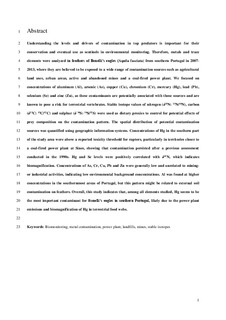| dc.contributor.author | Badry, Alexander | |
| dc.contributor.author | Palma, Luis | |
| dc.contributor.author | Beja, Pedro | |
| dc.contributor.author | Ciesielski, Tomasz Maciej | |
| dc.contributor.author | Dias, Andreia | |
| dc.contributor.author | Lierhagen, Syverin | |
| dc.contributor.author | Jenssen, Bjørn Munro | |
| dc.contributor.author | Sturaro, Nicolas | |
| dc.contributor.author | Eulaers, Igor | |
| dc.contributor.author | Jaspers, Veerle | |
| dc.date.accessioned | 2019-07-15T11:43:00Z | |
| dc.date.available | 2019-07-15T11:43:00Z | |
| dc.date.created | 2019-07-04T13:32:26Z | |
| dc.date.issued | 2019 | |
| dc.identifier.citation | Science of the Total Environment. 2019, 676 746-755. | nb_NO |
| dc.identifier.issn | 0048-9697 | |
| dc.identifier.uri | http://hdl.handle.net/11250/2605417 | |
| dc.description.abstract | Understanding the levels and drivers of contamination in top predators is important for their conservation and eventual use as sentinels in environmental monitoring. Therefore, metals and trace elements were analyzed in feathers of Bonelli's eagles (Aquila fasciata) from southern Portugal in 2007–2013, where they are believed to be exposed to a wide range of contamination sources such as agricultural land uses, urban areas, active and abandoned mines and a coal-fired power plant. We focused on concentrations of aluminum (Al), arsenic (As), copper (Cu), chromium (Cr), mercury (Hg), lead (Pb), selenium (Se) and zinc (Zn), as these contaminants are potentially associated with those sources and are known to pose a risk for terrestrial vertebrates. Stable isotope values of nitrogen (δ15N: 15N/14N), carbon (δ13C: 13C/12C) and sulphur (δ34S: 34S/32S) were used as dietary proxies to control for potential effects of prey composition on the contamination pattern. The spatial distribution of potential contamination sources was quantified using geographic information systems. Concentrations of Hg in the southern part of the study area were above a reported toxicity threshold for raptors, particularly in territories closer to a coal-fired power plant at Sines, showing that contamination persisted after a previous assessment conducted in the 1990s. Hg and Se levels were positively correlated with δ15N, which indicates biomagnification. Concentrations of As, Cr, Cu, Pb and Zn were generally low and unrelated to mining- or industrial activities, indicating low environmental background concentrations. Al was found at higher concentrations in the southernmost areas of Portugal, but this pattern might be related to external soil contamination on feathers. Overall, this study indicates that, among all elements studied, Hg seems to be the most important contaminant for Bonelli's eagles in southern Portugal, likely due to the power plant emissions and biomagnification of Hg in terrestrial food webs. | nb_NO |
| dc.language.iso | eng | nb_NO |
| dc.publisher | Elsevier | nb_NO |
| dc.rights | Attribution-NonCommercial-NoDerivatives 4.0 Internasjonal | * |
| dc.rights.uri | http://creativecommons.org/licenses/by-nc-nd/4.0/deed.no | * |
| dc.title | Using an apex predator for large-scale monitoring of trace element contamination: Associations with environmental, anthropogenic and dietary proxies | nb_NO |
| dc.type | Journal article | nb_NO |
| dc.type | Peer reviewed | nb_NO |
| dc.description.version | acceptedVersion | nb_NO |
| dc.source.pagenumber | 746-755 | nb_NO |
| dc.source.volume | 676 | nb_NO |
| dc.source.journal | Science of the Total Environment | nb_NO |
| dc.identifier.doi | 10.1016/j.scitotenv.2019.04.217 | |
| dc.identifier.cristin | 1710139 | |
| dc.relation.project | Norges forskningsråd: 230465 | nb_NO |
| dc.description.localcode | © 2019. This is the authors’ accepted and refereed manuscript to the article. Locked until 1 August 2021 due to copyright restrictions. This manuscript version is made available under the CC-BY-NC-ND 4.0 license http://creativecommons.org/licenses/by-nc-nd/4.0/ | nb_NO |
| cristin.unitcode | 194,66,10,0 | |
| cristin.unitname | Institutt for biologi | |
| cristin.ispublished | true | |
| cristin.fulltext | postprint | |
| cristin.qualitycode | 2 | |

